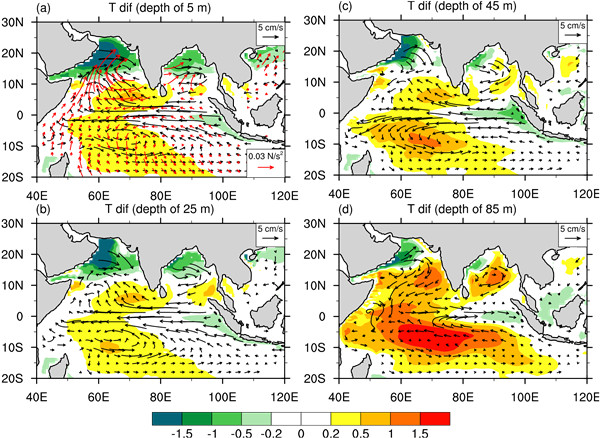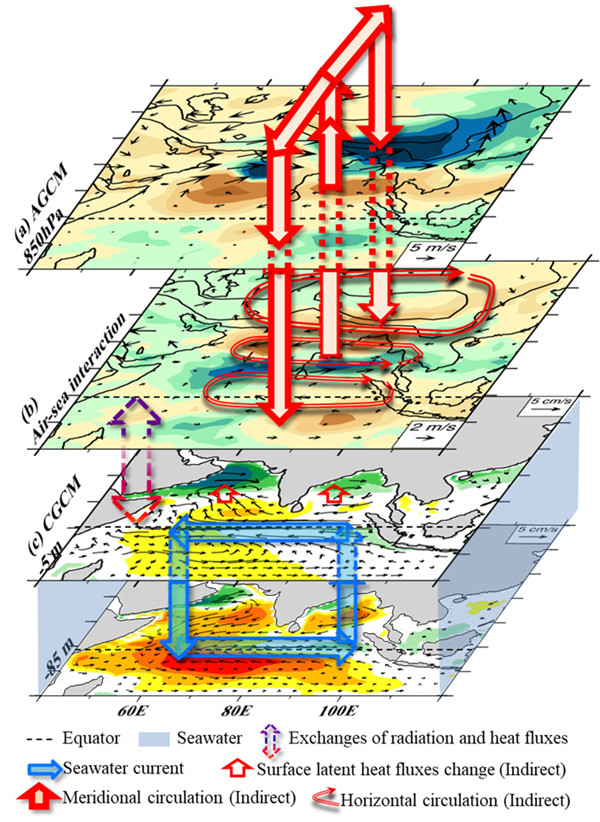State Key Laboratory of Numerical Modeling for Atmospheric Sciences and
Geophysical Fluid Dynamics (LASG)
Institute of Atmospheric Physics, Chinese Academy of Sciences

Vol. 7/No.7 October 2018
[Climate Dynamics]The role of air–sea interactions in regulating the thermal effect of the Tibetan–Iranian Plateau on the Asian summer monsoon
The influence of Tibetan–Iranian Plateau (TIP) on the Asian summer monsoon (ASM) is known to be important. However, the role of TIP on regulating air-sea interactions over surrounding oceans is not clear. In this study, the thermal effect of the TIP on the ASM and the role of air–sea interactions over the Indian Ocean in regulating the effects of the TIP are explored.
The results demonstrate that the direct thermal effect of the TIP produces a lower troposphere cyclonic circulation in the area surrounding the TIP and increases the continental precipitation over South and East Asia. It also decreases the precipitation over the tropical Indian Ocean and increases the sea-surface temperature (SST) of the tropical Indian Ocean with a large gradient zone located along 10°N but decreases SST of the western coast of Indonesia. In the lower troposphere, the air–sea interaction induced by the TIP thermal forcing produces an anticyclonic circulation surrounding the TIP and a stronger westerly flow to the south of the anticyclone. A circulation dipole thus forms to the south of the TIP. Together with this horizontal dipole, a meridional circulation dipole is generated to the south of the TIP, which is characterized by strong air ascent from 10 to 15°N where a strong westerly flow occurs, and the descent of air over the southern slope of the TIP and south Hemisphere. These results demonstrate that the indirect effect of the air–sea interaction over the Indian Ocean induced by the TIP thermal forcing is to counteract its direct effect on the Asian summer monsoon. The uncertainty of this indirect effect is also discussed.

June–July–August mean differences between the CON and TIPNS runs for the seawater temperatures (shaded, °C) and ocean currents (black vectors, cm s−1) at the depths of (a) 5 m, (b) 25 m, (c) 45 m, and (d) 85 m. The red arrows in (a) denote the surface wind stress (10−2 N s−2).

Fig. 2. Schematic diagram presenting the thermal effect of the TIP on the ASM. The direct effect of the TIP thermal forcing generates a cyclonic circulation in the lower troposphere around the TIP, while the indirect effect of the TIP thermal forcing generates an anticyclonic flow surrounding the TIP, and a cyclone–anticyclone circulation dipole to its south in the lower troposphere (fine red arrows), coupled with a pair of meridional circulations (bold red arrows), counteracting the TIP direct impact on the ASM.
Citation: He, B., Liu, Y., Wu, G. et al. (2018) The role of air–sea interactions in regulating the thermal effect of the Tibetan–Iranian Plateau on the Asian summer monsoon. Clim Dyn. https://doi.org/10.1007/s00382-018-4377-y
Contact: LIU Yimin, lym@lasg.iap.ac.cn; WU Guoxiong, gxwu@lasg.iap.ac.cn
E-mail: lasg_newsletter@lasg.iap.ac.cn
Editors: Chuanyi Wang (wangcy@lasg.iap.ac.cn), Kangjun Chen(ckj@lasg.iap.ac.cn)